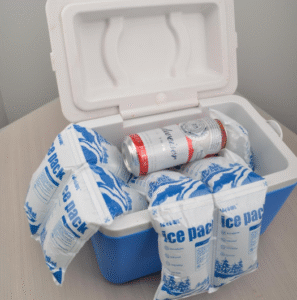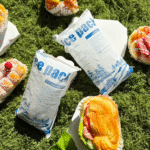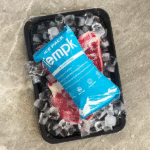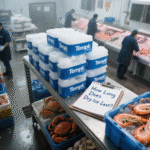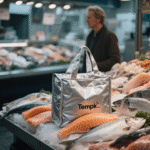إذا قمت بشحن البضائع المجمدة, أكياس الثلج الجاف تساعدك على البقاء متوافقة, ينظف, وباردة باستمرار. أنها تحتوي على كريات أو كتل مع السماح بالهروب من CO₂, لذلك يبقى منتجك متجمدًا ويظل المعالجون آمنين. يوضح هذا الدليل كيفية الحجم, علية, ملصق (UN1845), واختيار بدائل لمدة 24-72 ساعة في 2025.
-
متى تستخدم أكياس الثلج الجاف للممرات المجمدة وكيف تختلف عن الأكياس الهلامية وأكياس PCM
-
كم عدد أكياس الثلج الجاف التي تحتاجها حقًا لمدة 24-72 ساعة دون دفع مبالغ زائدة
-
كيفية وضع العلامات والتنفيس بشكل صحيح تحت UN1845 وIATA PI 954 في 2025
-
متى تختار الجل أو PCM بدلاً من ذلك لتجنب الخطوات الخطرة على الطرق المبردة
-
الاتجاهات ل 2025 التي تؤثر على المواد, قوائم مراجعة القبول, والاستدامة
ما هي أكياس الثلج الجاف ومتى يجب استخدامها?
إجابة قصيرة: أكياس الثلج الجاف متهمة, أكياس أو أكمام مقاومة للتمزق تحتوي على ثاني أكسيد الكربون الصلب داخل شاحن معزول حتى يتمكن الغاز من الهروب بينما تبقى بضائعك مجمدة. استخدمها عندما تحتاج إلى تحكم مجمد لعدة أيام (≤ −18 درجة مئوية), معالجة أكثر أمانًا, وحزم أكثر ترتيبًا من الكريات السائبة.
في الممارسة العملية: الحقيبة تفصل المبرد عن المنتج, يقلل من الفوضى, ويحسن الوضع حول الحمولة. تستخدم بعض الفرق أيضًا "أكياس حرارية" معزولة تحتوي على هلام أو ثلج جاف لإطالة وقت الانتظار في رسائل البريد وحقائب اليد. تأكد دائمًا من أن "الحقيبة" التي تشتريها مخصصة لاحتوائها الثلج الجاف وليس ال منتج.
أكياس الثلج الجاف مقابل. حزم هلام مقابل. أكياس PCM
خلاصة القول: توفر أكياس الثلج الجاف مساحة رأس فائقة البرودة; هلام وPCM عقد أضيق, نطاقات أكثر دفئًا مع حجز أبسط. يقع الجليد الجاف بالقرب من -78.5 درجة مئوية, بينما يحوم الهلام النموذجي حول 0-5 درجة مئوية ويمكن لطوب PCM أن يستهدف -20 درجة مئوية أو +5 درجة مئوية حسب الحاجة. استخدم أكياس الثلج الجاف للممرات شديدة التجمد والطرق الساخنة.
| خيار التبريد | النطاق النموذجي | الأفضل ل | ماذا يعني لك |
|---|---|---|---|
| أكياس الثلج الجاف | ~ -78.5 درجة مئوية | 24-96 ساعة مجمدة | يتطلب التنفيس وUN1845/الفئة 9 عن طريق الجو; أعلى قدرة تبريد. |
| أكياس PCM (على سبيل المثال, -20 درجة مئوية أو +5 درجة مئوية) | -25 درجة مئوية إلى +7 درجة مئوية | 12-36 ساعة مجمدة أو مبردة | رقابة أكثر صرامة دون أوراق المدير العام على العديد من الخدمات. |
| حزم هلام | 0-5 درجة مئوية | بين عشية وضحاها مبردة | سهل, قابل لإعادة الاستخدام, ولكن ليس للتجميد لفترة طويلة. |
نصائح عملية عندما تكون جديدًا في استخدام أكياس الثلج الجاف
-
لا تقم أبدًا بإغلاق ثاني أكسيد الكربون. استخدم أكياسًا مسامية أو أكياسًا ذات فتحات تهوية; لا تقم مطلقًا بإغلاق الحقيبة بالحرارة.
-
ما قبل الشرط. قم بتجميد المنتج بقوة وتبريد الشاحن مسبقًا لتقليل التحميل المبكر.
-
توزيع الكتلة. عدة أكياس صغيرة حول الحمولة تغلب على لبنة كبيرة واحدة.
لقطة من العالم الحقيقي: تحول أحد المخابز في شحن كعكات الآيس كريم من الكريات السائبة إلى أكياس الثلج الجاف وتنظيف القطع مع الحفاظ على ثبات وقت الانتظار من خلال التحكم في إجمالي الكيلوجرامات ومسارات التهوية.
كم عدد أكياس الثلج الجاف التي تحتاجها لمدة 24-72 ساعة؟?
قاعدة سريعة: ابدأ مع ~2.5-5 كجم لكل 24 ح لشاحن 10-15 لترًا في الطقس الدافئ, ثم قم بالضبط عن طريق اختبار المسار. انقسم عبر 2-4 أكياس ثلج جاف لزيادة مساحة السطح البارد والاستقرار.
لماذا يعمل: يمتص الثلج الجاف كمية كبيرة من الحرارة أثناء تساميه; التخطيط حسب مساحة السطح والبيئة المحيطة, ليس مجرد لتر, يعطي نتائج أكثر موثوقية.
| مدة | خفيف (≥22 درجة مئوية) | دافيء (23-30 درجة مئوية) | حار (≥31 درجة مئوية) | ما يجب القيام به |
|---|---|---|---|---|
| 12 ح | 1-2 كجم | 2-3 كجم | 3-4 كجم | 1– 2 كيس ثلج جاف لكل قطعة 12 L الشاحن. |
| 24 ح | 2.5-4 كجم | 4-6 كجم | 6-7 كجم | أضف أكياسًا جانبية لتعزيز مساحة السطح. |
| 48 ح | 5-7 كجم | 7-10 كجم | 10-12 كجم | ترقية العزل أو عدد الحقيبة. |
| 72 ح | 7-9 كجم | 10-13 كجم | 13-16 كجم | التحقق من صحة في ظروف ذروة الصيف. |
وضع وتنفيس أكياس الثلج الجاف
ضع أكياس الثلج الجاف في الأسفل والجوانب, مركز الحمولة, ثم قم بتغطية الحقيبة الأخرى. أبقِ البطانات مفتوحة والصندوق الخارجي قابل للتهوية; تجنب طبقات مسجلة بالكامل أو مبردات محكمة الغلق. ضع علامة على كتلة الثلج الجاف الصافية بالكيلوجرام.
عملي, نصائح جاهزة للمستخدم
-
حارة ساخنة? أضف PCM رقيقًا بدرجة حرارة -20 درجة مئوية بجوار المنتج; ادفع أكياس الثلج الجاف إلى الخارج.
-
وحدات SKU مختلطة? منفصلة بجزء داخلي صلب لمنع التكسير والبقع الباردة.
-
تلقي الملاحظات. قم بتضمين قسيمة تشير إلى "معبأة بالثلج الجاف" والكيلوغرام الصافي.
القضية باختصار: اثنين 2.5 أكياس ثلج جاف كجم بالإضافة إلى PCM رفيع بدرجة حرارة 20 درجة مئوية تحتوي على شحنة آيس كريم لمدة 48 ساعة تحت درجة حرارة 18 درجة مئوية على الرغم من تأخير المستودع لمدة ساعتين.
أيّ 2025 تنطبق القواعد على أكياس الثلج الجاف, وكيف يتم اجتياز القبول?
القاعدة الأساسية للهواء: علامة "الجليد الجاف" أو "ثاني أكسيد الكربون, صلب,"UN1845 و وزن الثلج الجاف الصافي (كجم) على نفس وجه الطبقة 9 ملصق. يجب أن تكون التعبئة والتغليف والحقائب تنفيس. غالبًا ما لا يكون إقرار الشاحن مطلوبًا عند استخدامه مع سلع غير خاضعة للإدارة العامة, لكن قوائم القبول لا تزال سارية.
الركاب مقابل. البضائع: عادةً ما تغطي الأمتعة الثلج الجاف عند 2.5 كجم لكل راكب بموافقة شركة الطيران والتعبئة والتغليف تنفيس; البضائع تتبع PI 954 وتغيرات المشغل. تعامل مع نقل الركاب كنظام مختلف.
قائمة مرجعية سريعة للامتثال لأكياس الثلج الجاف (نسخ/لصق إلى SOP)
-
استخدم أكياس الثلج الجاف المصممة خصيصًا لهذا الغرض; لا ختم ثاني أكسيد الكربون في البلاستيك.
-
أبقِ البطانات مفتوحة; ضمان خارجي قادر على التنفيس.
-
علامة UN1845, الاسم الصحيح, و صافي كجم; تطبيق الفصل 9 ملصق.
-
احجز خدمة تقبل الثلج الجاف; أضف تفاصيل AWB كما هو مطلوب.
أكياس الثلج الجاف أو البدائل: الذي يناسب حارتك?
اختر أكياس الثلج الجاف عندما يجب عليك إبقاء المنتج مجمداً من البداية إلى النهاية, يتجاوز العبور 36 ساعات, أو القمم المحيطة فوق 30 درجة مئوية. اختر أكياس PCM للعصابات الضيقة (-20 درجة مئوية أو +5 درجة مئوية) بدون أوراق المدير العام. اختر الجل للتوصيلات المبردة خلال النهار أو أثناء الليل.
فحص المسار لمدة دقيقتين (التقييم الذاتي)
-
يجب أن تظل الحمولة مجمدة صلبة?
-
سوف يتجاوز العبور 36 ساعات من الباب إلى الباب?
-
سوف تتجاوز درجة الحرارة المحيطة 30 درجة مئوية على الطريق?
-
هل يقبل مشغل شبكة الجوال UN1845 في خدمتك؟?
إذا راجعت 3+ صناديق, تصميم حول أكياس الثلج الجاف; وإلا قم بتجربة حزمة PCM-first.
2025 التطورات والاتجاهات لأكياس الثلج الجاف
ما الجديد: قام المشغلون بتحديث قبول المساعدات الوظيفية للتأكيد على التنفيس, حجم التسمية, ورؤية صافية كجم. توسع بائعو التغليف "أكياس الثلج الجاف" الورقية والحقائب الحرارية المعزولة; تنضج المواد الهلامية القابلة للتحلل كبدائل قصيرة المدى عندما يكون الثلج الجاف محدودًا.
الأحدث في لمحة
-
إرشادات واضحة "لا يوجد بلاستيك مختوم". في قوائم التحقق من القبول يقلل من مخاطر الرفض.
-
خيارات الحقيبة البيئية قطع النفايات مع تحسين التحكم في الرطوبة داخل الصناديق.
-
شركات الشحن ذات الإستراتيجية المزدوجة يفوز: أكياس الثلج الجاف للطرق الساخنة بين الولايات, أكياس PCM للاختصار, الممرات المنظمة.
نظرة السوق: يؤدي النمو في البقالة الإلكترونية المجمدة والمواد البيولوجية إلى دفع استراتيجيات التبريد المختلطة والعزل الأفضل, مع هندسة العبوة التي تم التحقق من صحتها والتي تبين أنها تهم بقدر إجمالي الكيلوجرامات.
الأسئلة المتداولة حول أكياس الثلج الجاف
س 1: هل أكياس الثلج الجاف هي نفسها أكياس الثلج محكمة الغلق بالفراغ؟?
لا. يجب أن تقوم أكياس الثلج الجاف بتنفيس الغاز لتكون آمنة ومتوافقة; إن الختم الفراغي لثاني أكسيد الكربون غير آمن.
Q2: هل يمكنني وضع أكياس الثلج الجاف داخل بطانة بولي؟?
نعم، احتفظ بالبطانة يفتح لذلك يمكن أن يهرب co₂; يجب أيضًا تنفيس العبوة الخارجية.
س 3: ما هي كمية الثلج الجاف التي أحتاجها 48 ساعات?
يخطط ~5-9 كجم لمبرد صغير في الطقس الدافئ, مقسمة عبر أكياس متعددة. التحقق من صحة على المسار الخاص بك.
س 4: ما هي الملصقات التي توضع على صندوق به أكياس ثلج جاف?
يتقدم UN1845, الاسم الصحيح, صافي كيلوغرام, و فصل 9 التسمية على نفس الوجه.
س 5: هل تعمل أكياس الثلج الجاف في شحنات المواد الغذائية?
نعم. تمنع الاتصال المباشر بالكريات وتقلل من الفوضى, مثالي ل علبة ثلج جاف لشحن المواد الغذائية سيناريوهات. استخدم عبوات وقفازات ذات فتحات تهوية.
ملخص وتوصيات لأكياس الثلج الجاف
يتذكر: تعمل أكياس الثلج الجاف على جعل الشحن المجمد أكثر نظافة وأمانًا من خلال احتوائه على كريات مع السماح لثاني أكسيد الكربون بالتنفيس. تمرير القبول عن طريق وضع علامة UN1845 بالكيلوجرامات الصافية واستخدام الأجزاء الخارجية القابلة للتهوية. الحجم حسب الطريق, المحيط, ومساحة السطح بدلاً من اللترات وحدها.
الخطوات التالية: خريطة وقت المسار الخاص بك والبيئة المحيطة, تبدأ في 2.5-5 كجم لكل 24 ح, مقسمة عبر أكياس متعددة من الثلج الجاف, وقم بإجراء تجربة واحدة. توحيد إجراءات التشغيل القياسية (SOP) والتسميات الخاصة بك, ثم اضبط ±1 كجم بناءً على البيانات.
حول Tempk
نحن نساعد الطعام, فارما, وتختار فرق التكنولوجيا الحيوية شركات الشحن المعتمدة, مقاس أكياس الثلج الجاف أو PCMs بدقة, وترجمة 2025 قواعد القبول في قوائم مرجعية سهلة. ميزتنا هي الآلات الحاسبة العملية, اختبار المسار الحقيقي, وإجراءات التشغيل المعيارية (SOPs) سريعة التجهيز والتي تقلل من المطالبات والتكلفة.
CTA: مشاركة حجم الصندوق الخاص بك, خط, واستهداف الموظفين المؤقتين — احصل مجانًا, الحزمة ومجموعة الملصقات الخاصة بالمسار اليوم.






